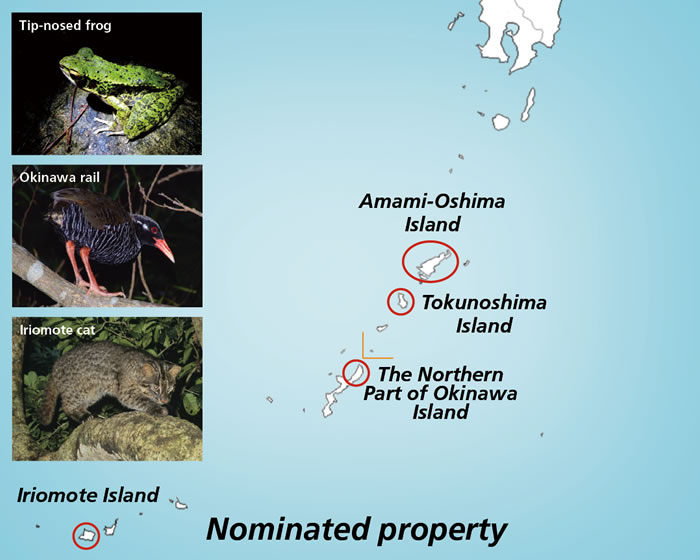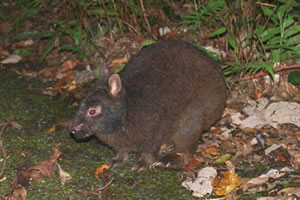Feature
Aiming for the Fifth World Natural Heritage Site in Japan
Ministry of the Environment has submitted to UNESCO a document of nomination of Amami-Oshima Island, Tokunoshima Island, the northern part of Okinawa Island and Iriomote Island for Inscription the World Heritage List. The nominated property is characterized by many examples of unique biological evolution which reflects the geohistory of the islands such as Amami rabbit (Pentalagus furnessi) and Okinawa rail (Gallirallus okinawae). If the nomination process goes smoothly, UNESCO's World Heritage Committee will discuss whether to inscribe the property on the List in the summer of 2018.


Amami rabbit (Pentalagus furnessi)
Ministry of the Environment (MOE) has recently submitted to UNESCO a document to nominate Amami-Oshima Island, Tokunoshima Island, the northern part of Okinawa Island and Iriomote Island, collectively, for the World Heritage List, so that the area may be inscribed as the fifth World Natural Heritage site in Japan.
The area was selected as one of the candidates for nomination in Japan in 2003 after scientific consideration. Although it was well appreciated that the area was worthy of inscription, a lack of domestic protected area has been a major challenge for the nomination. Over a decade later, the area was finally nominated for the World Heritage List as measures to secure domestic protected areas, such as designation of Yambaru National Park and Amami Gunto National Park, were put in place, which was a prerequisite for the nomination.
What is World Natural Heritage?
Natural and cultural properties such as archaeological remains and natural areas have been inscribed on the World Heritage List based on the World Heritage Convention to protect such properties as the legacy of the world and all humankind. The sites are divided into three categories: cultural, natural and mixed, in accordance with the characteristics of the properties. Currently, Japan has four World Natural Heritage sites: Yakushima, Shirakami-Sanchi, Shiretoko and Ogasawara Islands. In order for a property to be inscribed on the World Heritage List, the property must have not only precious nature but also an outstanding universal value that meets the World Heritage registration criteria, and such value must be adequately protected.
Value as a World Heritage Site
The outstanding universal value of the site nominated this time, "Amami-Oshima Island, Tokunoshima Island, the northern part of Okinawa Island and Iriomote Island," can be described briefly as "unique biological evolution which reflects the geohistory of the islands in subtropical regions."
The nominated site used to be a part of the continent and had common terrestrial organisms with the continent. Afterwards, the area was separated from the continent and formed small islands, in which process various speciations and endemisms occurred. Amami rabbit (Pentalagus furnessi), Tip-nosed frogs (Odorrana), Okinawa rail (Gallirallus okinawae) and Iriomote cat (Prionailurus bengalensis iriomotensis) are typical examples. The nominated site consists of four areas representing different distances and times of separations from the continent, and nominating all those areas collectively has been recognized as a good way to demonstrate the process of speciation and systematic diversification reflecting the geohistory of the islands.
For the Future
If the nomination process goes smoothly, UNESCO's World Heritage Committee will discuss whether to inscribe the property on the List in the summer of 2018. MOE will, in cooperation with concerned parties, work towards the inscription on the World Heritage List while promoting appropriate management of the national parks in which the four areas are located, conservation of rare species, measures against alien species affecting the rare species, etc. to properly protect the nominated site.
We hope that our efforts to have the site inscribed on the World Heritage List in cooperation with local residents and other stakeholders will give many people an opportunity to look at the existence of endemic organisms on the four islands, think of how the area looked like several million years ago and how the islands were formed, become aware of the preciousness of the natural environment that remains only on these islands and start or continue actions to preserve it.
More Information:


